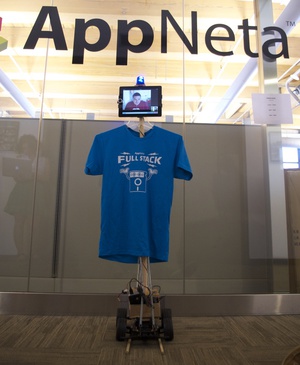Sensing the popularity of Telepresence robotics, Ari Rizzitano who works in AppNeta, decided to build a Telepresence robot to be utilized in the office. It was named as Petbot which stands for Providence Engineering Telepresence Bot. Since the organization had its employees working at distant places, the need for video conferencing was inevitable. This made Ari think about making a robot by combining his recently acquired iPad with a microcontroller. So he started working on the idea and the end result was a Petbot which could move, talk and walk around the premises.

Figure 1: Petbot
This DIY robot is mainly built by mounting an iPad on an RC car chassis and is controlled with the help of web interface. The car is operated by a radio transmitter which is wired to a Raspberry Pi. There are 2 servers involved in the process, whereby the local server connects to the remote server thus enabling the Pi to receive commands from anywhere in the word with low latency. The bot could be powered by either an Arduino board along with USB cable or a Raspberry PI with Wi-Fi dongle. However, in this case, the absence of a Wi-Fi connection didn’t allow the car to travel beyond the range of the transmitter. In order to fix this, Ari opted for the latter option and mounted the Pi as well as a transmitter on the Petbot.
To build the Petbot, he started gathering the components namely an RC car (desert blaster), resistors, transistor, breadboard, scrap plywood, cardboard, iPad brackets, compression springs, carriage bolts, nuts, washers, bowels, etc. For preparing the circuit, he dismantled the remote of the car and reached to its board so as to solder the connection to some leads which were in turn connected to the Arduino pins through transistors. The same method would work for the Raspberry Pi.
When the circuit was complete, he started with the testing of the setup to make sure that the robot could be controlled from a web interface with latency similar to that of a video chat program. For this, he made use of socket.io on node.js as it helped in transmitting the messages between browsers and servers. To control the server, he used a local server to catch the user initiated events and a remote server to re-broadcast these inputs.
Finally coming to the chassis portion, a lot of things had to be considered like the height and weight of the setup so that the bot looked balanced enough and could conveniently accommodate the iPad with just the right measurements. In order to prevent it from tilting, Ari even used two skid plates at the bottom of the car. Further, he used the iPad box to house the Raspberry Pi assembly and the battery pack. For mounting the iPad, he directly screwed the Pi brackets on the post and then after placing the springs into place, the chassis was ready to be operated.
As per Ari, this Petbot is highly customizable and holds a lot of scope for improvement not only in terms of its looks but the coding can also be improvised. Although it is not at par with the other Telepresence robots available in the market but it performs almost similar kinds of functions at a fraction of the cost. A video of this project has been uploaded by AppNeta where you can look at the Petbot in action. For the rest of the details about the hardware and software, you can visit the following link.
Filed Under: Reviews


Questions related to this article?
👉Ask and discuss on EDAboard.com and Electro-Tech-Online.com forums.
Tell Us What You Think!!
You must be logged in to post a comment.